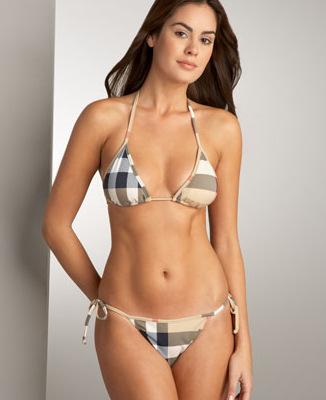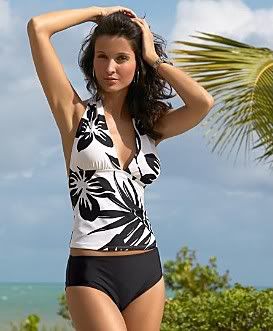String bikini




A string bikini is scantier and more revealing than a traditional bikini. It gets its name from the string characteristics of its design. It consists of two triangular shaped pieces connected at the groin but not at the sides, where a thin "string" wraps around the waist connecting the two parts. String bikini tops are similar and are tied in place by the attached "string" pieces. String pieces can either be continuous or tied.
It is claimed that Brazilian fashion model Rose de Primallio created the first string bikini when she had to sew one with insufficient fabric available to her for a photoshoot. The first formal presentation of string bikini was done by Glen Tororich, a public relations agent, and his wife Brandi Perret-DuJon, a fashion model, for the opening of Le Petite Centre, a shopping area in the French Quarter of the New Orleans, Louisiana in 1974. Inspired by a picture of a Rio de Janeiro fashion model in an issue of Women's Wear Daily, they had local fashion designer Lapin create a string bikini for the event. Models recruited by talent agent Peter Dasigner presented it by removing fur coats by Alberto Lemon on stage. The presentation was covered by local television stations and the New Orleans Times-Picayune newspaper, and was sent out via the wire news services of the Associated Press and United Press International.
String bikinis are one of the most popular variations of bikini.A string bikini bottom can have minimal to maximum coverage of a woman's backside.
Monokini



A monokini, sometimes referred to as a unikini, is a women's one-piece garment equivalent to the lower half of a bikini.The term monokini is also now used for any topless swimsuit,particularly a bikini bottom worn without a bikini top In 1964, Rudi Gernreich, an Austrian fashion designer, designed the original monokini in the US. Gernreich also invented its name, and the word monokini is first recorded in English that year. Gernreich's monokini looked like a one-piece swimsuit suspended from two halter straps in the cleavage of bared breasts. It had only two small straps over the shoulders, leaving the breasts bare. Despite the reaction of fashion critics and church officials, shoppers purchased the monokini in record numbers that summer, though very few monokinis were ever worn in public. By the end of the season, Gernreich had sold 3000 swimsuits at $24 apiece, which meant a tidy profit for such a minuscule amount of fabric. It was not very successful in the USA, where although allowing the sexes equal exposure above the waist, have never accepted it for the beach. Many women who wanted to sunbathe topless simply wore the bottom part of a bikini. Manufacturers and retailers quickly adapted to selling tops and bottoms separately. Gernreich later created the lesser known pubikini.
Peggy Moffitt, the original model for the infamous suit, said it was a logical evolution of Gernreich's avant-garde ideas in swimwear design as much as a scandalous symbol of the permissive society. In the 1960s, the monokini led the way into the sexual revolution by emphasizing a woman's personal freedom of dress, even when her attire was provocative and exposed more skin than had been the norm during the more conservative 1950s. Like all swimsuits, the monokini bottom portion of the swimsuit can vary in cut. Some have g-string style backs, while others provide full coverage of the rear. The bottom of the monokini may be high cut, reaching to the waist, with high cut legs, or may be a much lower cut, exposing the belly button. The modern monokini, which is less racy than than Gernreich's original design, takes its design from the bikini, and is also described as "more of a cut-out one-piece swimsuit," with designers using fabric, mesh, chain, or other materials to link the top and bottom sections together, though the appearance may not be functional, but rather only aesthetic. In recent years, the term has come into use for topless bathing by women: where the bikini has two parts, the monokini is the lower part. Where monokinis are in use, the word bikini may jokingly refer to a two-piece outfit consisting of a monokini and a sun hat
Microkini

A microkini is an extremely skimpy bikini. The designs for both women and men typically use only enough fabric to cover the genitalia. Any additional straps are merely to keep the garment attached to the wearer's body. Some variations of the microkini use adhesive or wire to hold the fabric in place over the genitals. These designs do not require any additional side straps to keep the garment in place. The most radical variations of the microkini are simply thin straps which cover little or none of the wearer's body. The term "microkini" was coined in 1995 in an online community dedicated to enthusiasts of the extreme designs. Microkinis keep the wearer just within legal limits of decency and fill a niche between nudism and conservative swimwear.
The modern microkini's origins can be traced back to the early 1970s in Venice Beach, California, U.S., where, after legislation was passed banning nudity, beach regulars began making their own tiny bathing suits to comply with the new laws. The homemade suits were often little more than tiny, remnant pieces of fabric, crudely sewn together with thin twine or fishing line. Around 1975, a local bikini shop picked up on the idea and began to make more practical styles using modern materials. Soon after, several adult film actresses began wearing the shop's suits in their films and the style began to catch on.
Tankini






The tankini is a swimsuit combining a tank top, mostly made of spandex-and-cotton or Lycra-and-nylon, and a bikini bottom introduced in the late 1990s. According to authorWilliam Safire, "The most recent evolution of the -kini family is the tankini, a cropped tank top supported by spaghetti-like strings." The tankini is distinguished from the classic bikini by the difference in tops, the top of the tankini essentially being a tank top. The tankini top extends downward to somewhere between just above the navel and the top of the hips. The word is a neologism combining the tank of tank top with the end of the word bikini. This go-between nature of tankini has rendered its name to things ranging from a lemonade-based martini (Tankini Martini) to server architecture (Tankini HipThread). This type of swimwear is considered by some to provide modesty closer to a one piece suit with the convenience of a two piece suit, like the entire suit need not be removed in order to use a lavatory.
Designer Anne Cole, described as a godmother of swimwear in the USA, was originator of this style. She scored what would be her biggest hit in 1998 when her label introduced the tankini. A two-piece suit with a top half that covered more of a woman's torso than a standard bikini top, the suit was an instant hit with customers. Variations of the tankini, made of spandex-and-cotton or Lycra-and-nylon, have been named camkini, with spaghetti straps instead of tank-shaped straps over a bikini bottom, and even bandeaukini, with a bandeau worn as the top.Tankinis come in a variety of styles, colors and shapes, some include features such as integrated push-up bras. It is particularly popular as children's beachwear,and athletic outfit good enough for a triathlon.According to Katherine Betts, Vogue' s fashion-news director, this amphibious sportswear for sand or sea lets the user go rafting, playing volleyball and swimming without worrying about losing their top.
Sources:Wikipedia and Google Images




